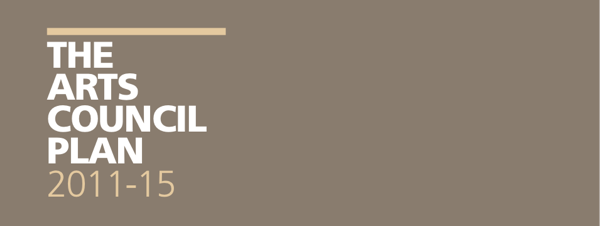The Arts Council have just released their plan for 2011-2015, setting out what they’ll do to deliver their ‘Achieving great art for everyone’ goals and priorities.
On the digital side of things, there are various references to partnership, co-production and building capacity, while IP is flagged as a ‘challenge’. It’s all fairly top-line stuff as you’d expect, and you should always be wary of reading the digital bits in isolation from the rest, but here’s what’s worth pulling out.
The meat of it is on p10:
Digital innovation
Digital technology has huge potential to support and accelerate the delivery of all of our goals and priorities and offers exciting opportunities for artists, audiences and the broader sector. We will work with partners, including National portfolio organisations, to build capacity and increase skills sharing. We will encourage distribution of excellent art through digital platforms and archiving to extend its life and reach. We will encourage an approach that promotes openness, generosity and sharing for the public good, working with partners to develop policy and support with regards to intellectual property – a key building block and challenge to growth and innovation in digital media. We will seek to open up opportunities that lead to new revenue streams and align our investment with other partners to increase impact and public value.
The plan also has some information specific to different parts of the country – there’s no real detail here but, for the sake of pulling it together, here’s what there is:
East and South East (p18)
There is great potential to increase the digital capacity of arts organisations in the area, as this will become one of the primary means of increasing reach. The area has some of the UK’s most vibrant cultural new media and digital development sectors and is home to global digital businesses like Disney, Second Life and Microsoft. We have invited Lighthouse, Brighton to be the area strategic lead in digital arts research and development, exhibition, co-production and distribution
London (p21)
We intend to support consistent and strategic partnerships and alliances with a range of partners, including commercial promoters and publishers and digital providers, to better understand and exploit the value of the subsidised arts offer.
Midlands and South West (p22)
We will skill up the sector in the use of digital platforms to extend reach and accessibility for audiences.
North (p24)
We will build on the area’s strong track record in digital, for example through building partnerships with Media City in Salford
Also announced by today the Arts Council were details of £440m of strategic funding. The most interesting elements of this (from my point of view) being:
- Audience focus grant commissions, designed to help funded organisations understand, retain and grow their audiences
- General strategic grants, with the website specifically saying “this could include for example work around digital innovation”

